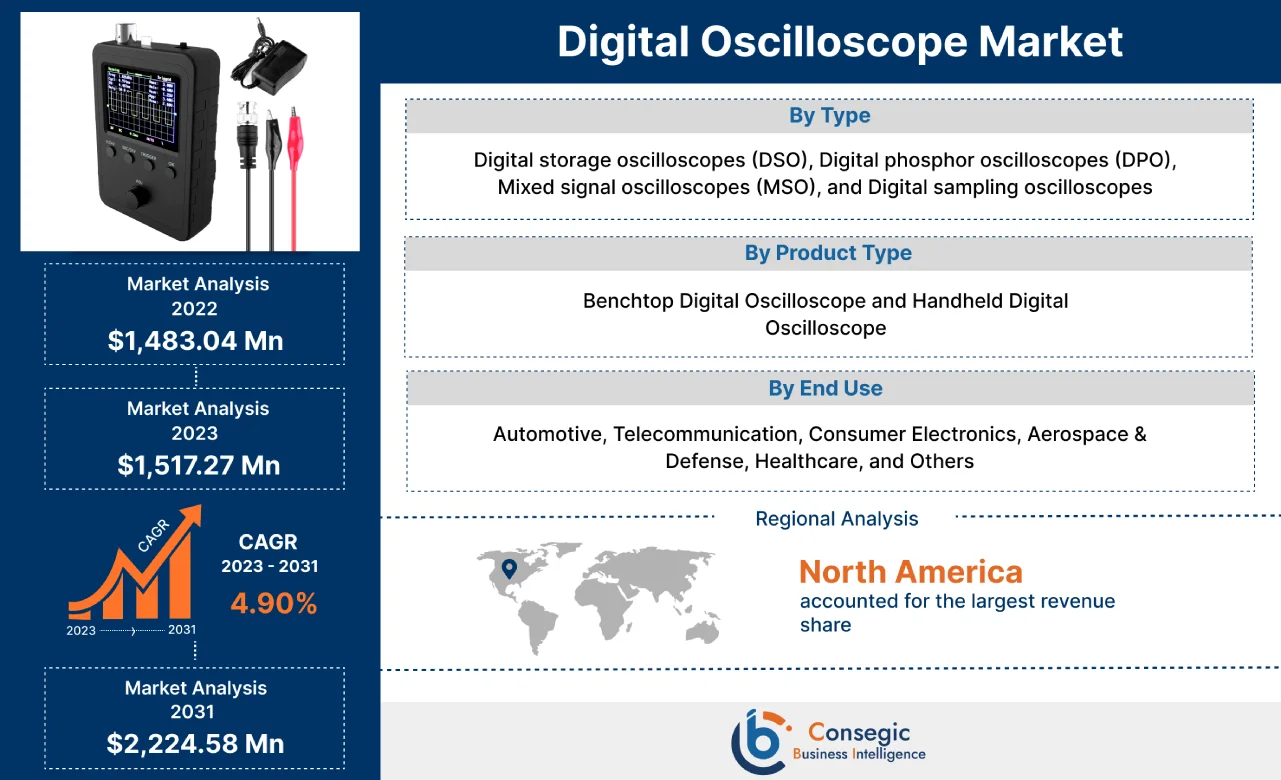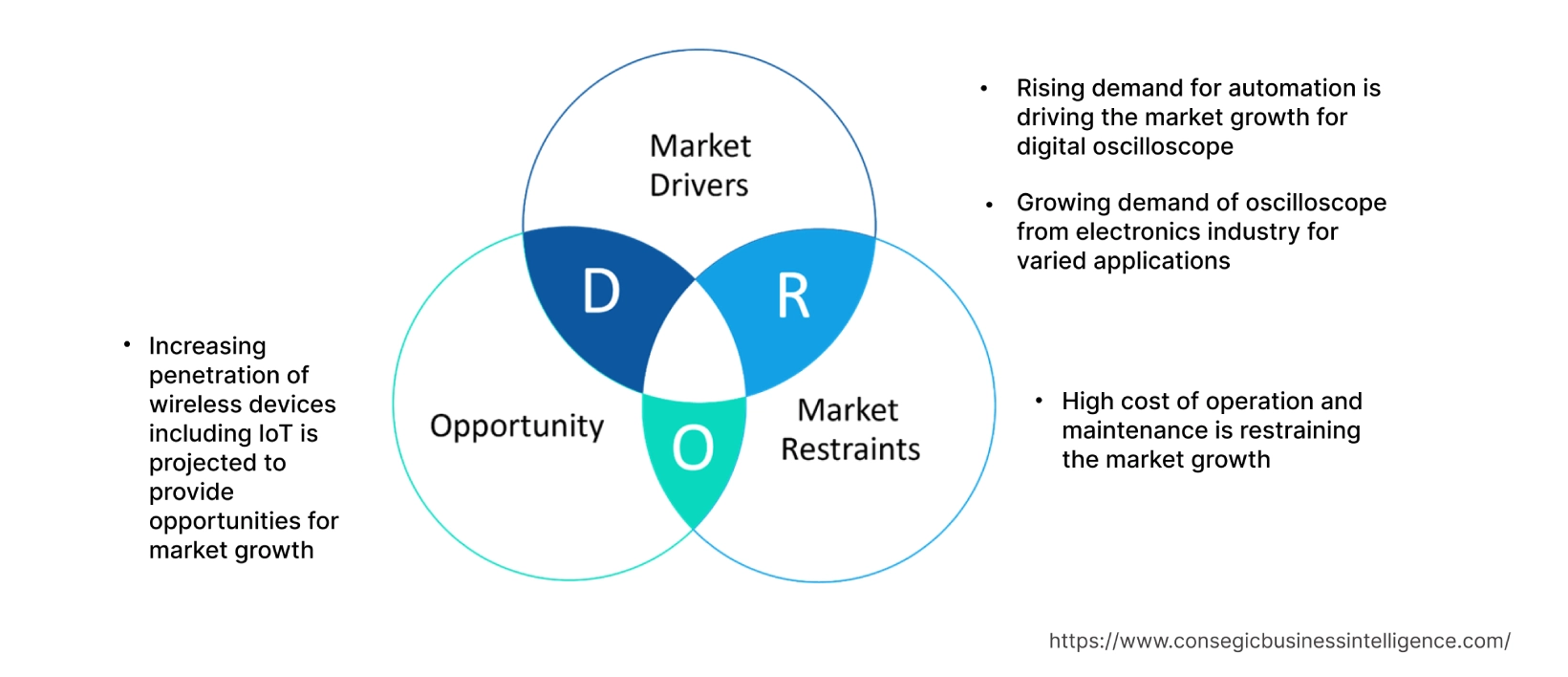Digital Oscilloscope Market Size :
Digital Oscilloscope Market size is estimated to reach over USD 2,379.39 Million by 2032 from a value of USD 1,567.04 Million in 2024 and is projected to grow by USD 1,623.11 Million in 2025, growing at a CAGR of 4.9% from 2025 to 2032.
Digital Oscilloscope Market Scope & Overview:
A digital oscilloscope is an electronic instrument that measures and displays electrical signals, converting them into a digital format for storage and analysis. It works by sampling the input signal, converting it to digital data, and then displaying this data on a screen. Key benefits include signal storage, advanced triggering, mathematical analysis, multiple channels, high resolution and accuracy, and zoom/pan capabilities. These oscilloscopes store captured waveforms for later analysis, unlike analog oscilloscopes. They offer superior resolution and accuracy due to high-speed Analog-to-Digital Converters (ADCs) and greater bit depth.
Digital Oscilloscope Market Insights :
Digital Oscilloscope Market Dynamics - (DRO) :
Key Drivers :
Rising demand for automation is driving the market growth
Digital storage oscilloscope (DSO) combined with automation offers significant benefits in productivity, accuracy, and cost savings. Automation streamlines repetitive tasks, allowing faster data acquisition, analysis, and reporting. This leads to increased efficiency, reduced errors, and more productive and cost-effective workflows. Automation handles repetitive tasks, freeing up engineers and technicians to focus on more complex analysis and problem-solving, leading to higher output and faster turnaround times. Automated testing sequences minimize human error, ensuring more reliable and consistent results. By reducing manual effort and minimizing errors, automation can lead to significant cost reductions in testing and analysis.
- For instance, Aplab Global launched DSO series of oscilloscopes that operate at 70 MHz to 200 MHz having 2 channels. The flagship products include D37200A, D37100A, and D37070A that feature 32 automatic measurement and track measurements.
Thus, the aforementioned factors are boosting the adoption of oscilloscopes, in turn driving the digital oscilloscope market growth.
Key Restraints :
High cost of operation and maintenance is restraining the market growth
Digital oscilloscopes are expensive to purchase initially and their operation and maintenance also incur high costs. These costs arise from the complex components, high-end features, and the need for specialized expertise for maintenance. Oscilloscopes contain expensive components such as transistors, tubes, and capacitors, which can drive up repair costs. Maintenance often requires skilled technicians, which leads to high hourly rates. Additionally, significant upgrades or required calibration are costly, potentially adding to the overall expense.
Thus, the market analysis shows that the aforementioned factors are restraining the digital oscilloscope market demand.
Future Opportunities :
Increasing penetration of wireless devices is projected to provide opportunities for market growth
The increasing adoption of wireless devices, particularly in areas like IoT (Internet of Things), is significantly impacting the digital oscilloscope market. Digital oscilloscopes are crucial for testing and debugging these wireless devices, as they generate electrical signals that need to be analyzed. The rising number of wireless devices is expected to drive more prospects for digital oscilloscope sales and advancements in their capabilities. Digital oscilloscopes are used to visualize and analyze these electrical signals, enabling engineers to identify issues within the device or its components.
Thus, the ongoing advancements in wireless devices are projected to drive digital oscilloscope market opportunities during the forecast period.
Digital Oscilloscope Market Segmental Analysis :
By Type :
Based on the type, the market is segmented into digital storage oscilloscopes (DSO), digital phosphor oscilloscopes (DPO), mixed signal oscilloscopes (MSO), and digital sampling oscilloscopes.
Trends in the Type:
- Increasing demand for mixed signal oscilloscopes (MSO) to allow engineers to simultaneously view and analyze both analog and digital signals is boosting the digital oscilloscope market size.
- Rising trend in adoption of digital sampling oscilloscopes, due to features including waveform storage, advanced triggering, and automated measurements.
The digital storage oscilloscopes (DSO) segment accounted for the largest revenue share of 34.50% in the market in 2024.
- DSOs capture, store, and analyze waveforms, making them valuable for debugging, design, and research across various fields.
- They offer several advantages over traditional analog oscilloscopes, primarily due to their storage and digital processing capabilities.
- Moreover, they also provide advanced triggering, measurement, and display features, enhancing their versatility and ease of use.
- Additionally, several DSOs provide automated measurement capabilities, allowing quick and accurate determination of various signal parameters including frequency, amplitude, rise time, and fall time.
- Therefore, the aforementioned factors are boosting the digital oscilloscope market growth.
The digital phosphor oscilloscopes (DPO) segment is expected to register the fastest CAGR during the forecast period.
- DPOs use color to show the frequency of signal occurrences, allowing users to easily identify and characterize signal anomalies and infrequent events.
- DPOs capture a large number of waveforms per second, increasing the probability of capturing transient events and revealing dynamic signal behavior.
- They provide real-time insights into signal behavior, making them suitable for a wide range of applications, including design, debugging, and troubleshooting.
- The intensity-graded display and high capture rate help engineers quickly identify and isolate signal faults and intermittent problems.
- Thus, the aforementioned factors are expected to boost the digital oscilloscope market trends during the forecast period.
By Product Type :
Based on the product type, the market is segmented into benchtop and handheld.
Trends in the Product Type:
- Rising demand for benchtop oscilloscopes, due to its benefits including higher performance, larger displays, intuitive controls, and advanced signal analysis features is boosting the digital oscilloscope market size.
- Increasing trend in adoption of handheld oscilloscopes due to factors including portability, convenience, versatility, and others.
The benchtop segment accounted for the largest revenue share in the digital oscilloscope market share in 2024.
- Benchtop oscilloscopes generally offer higher bandwidth, lower noise, refined processing, and faster responsiveness in comparison to smaller, portable options.
- The larger displays facilitate easier viewing and analysis of waveforms, particularly when dealing with complex signals.
- Built-in interfaces and control knobs/buttons make them user-friendly and easy to operate, even for those who are less familiar with digital oscilloscopes.
- Moreover, they often include advanced features like signal processing, mathematical operations, automatic measurements, and storage capabilities, which can be very helpful for in-depth signal analysis.
- Further, benchtop oscilloscopes are often available with various connectivity options, allowing users to connect to PCs for data transfer, storage, and printing, or to link with other instruments for more comprehensive system analysis.
- Therefore, the aforementioned factors are boosting the digital oscilloscope market demand.
The handheld segment is expected to register the fastest CAGR during the forecast period.
- Handheld digital oscilloscopes offer several advantages, primarily due to their portability and digital functionality.
- They are smaller and lighter than traditional benchtop models, making them ideal for field work and on-the-go troubleshooting.
- Moreover, their digital nature provides features like waveform storage, automated measurements, and advanced analysis capabilities that are not available in older analog models.
- Additionally, many handheld oscilloscopes are designed to withstand rugged environments, making them suitable for field work.
- Thus, the aforementioned factors are expected to boost the digital oscilloscope market trends during the forecast period.
By End-User :
Based on the end use, the market is segmented into automotive, telecommunication, consumer electronics, aerospace & defense, healthcare, and others.
Trends in the End Use:
- Rising demand for digital oscilloscopes in the healthcare industry for precise measurement and analysis of electrical signals, which is crucial for understanding and diagnosing various physiological phenomena like heartbeats, brainwaves, and other biological signals.
- Increasing trend in the adoption of digital oscilloscopes in the aerospace & defense industry for testing, troubleshooting, and analyzing complex electronic systems.
The telecommunication segment accounted for the largest revenue share in the digital oscilloscope market share in 2024.
- Digital oscilloscopes are crucial tools in telecommunications for analyzing and troubleshooting high-frequency signals and maintaining signal integrity.
- They enable the measurement and characterization of modulated signals (AM, FM, PM) and are essential for verifying the performance of wireless communication systems.
- Moreover, oscilloscopes with high bandwidth and fast sampling rates are required to analyze radio frequency (RF) waveforms, perform spectral analysis, and verify the operation of wireless communication systems.
- Oscilloscopes are also used to test and verify the performance of antennas in transmitting and receiving signals.
- Therefore, the aforementioned factors are boosting the digital oscilloscope market expansion.
The consumer electronics segment is expected to register the fastest CAGR during the forecast period.
- Digital oscilloscopes, which are used to visualize electrical signals, are finding increasing applications in consumer electronics.
- They help in debugging and troubleshooting devices, analyzing signal behavior, and ensuring proper functionality of electronic components in products such as smartphones, gaming consoles, and home appliances.
- DSOs also offer features including automated measurements, waveform storage, and advanced triggering, which are crucial for analyzing complex signals.
- Thus, the aforementioned factors are expected to boost the digital oscilloscope market opportunities during the forecast period.
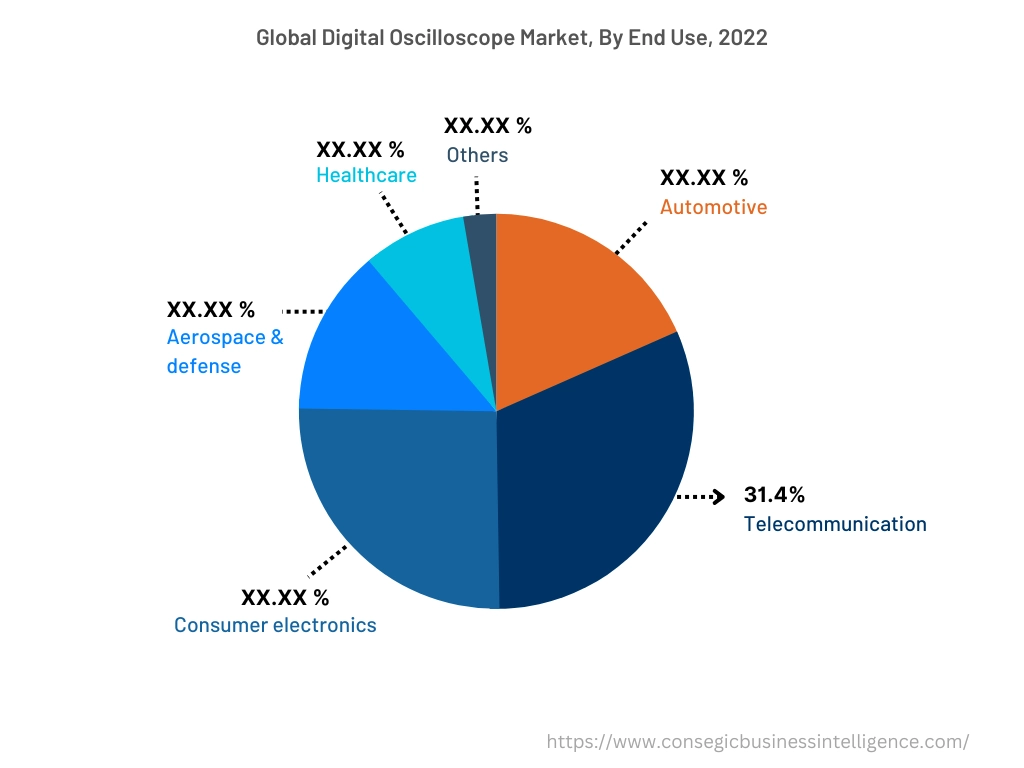
By Region :
The regions covered are North America, Europe, Asia Pacific, the Middle East and Africa, and Latin America.
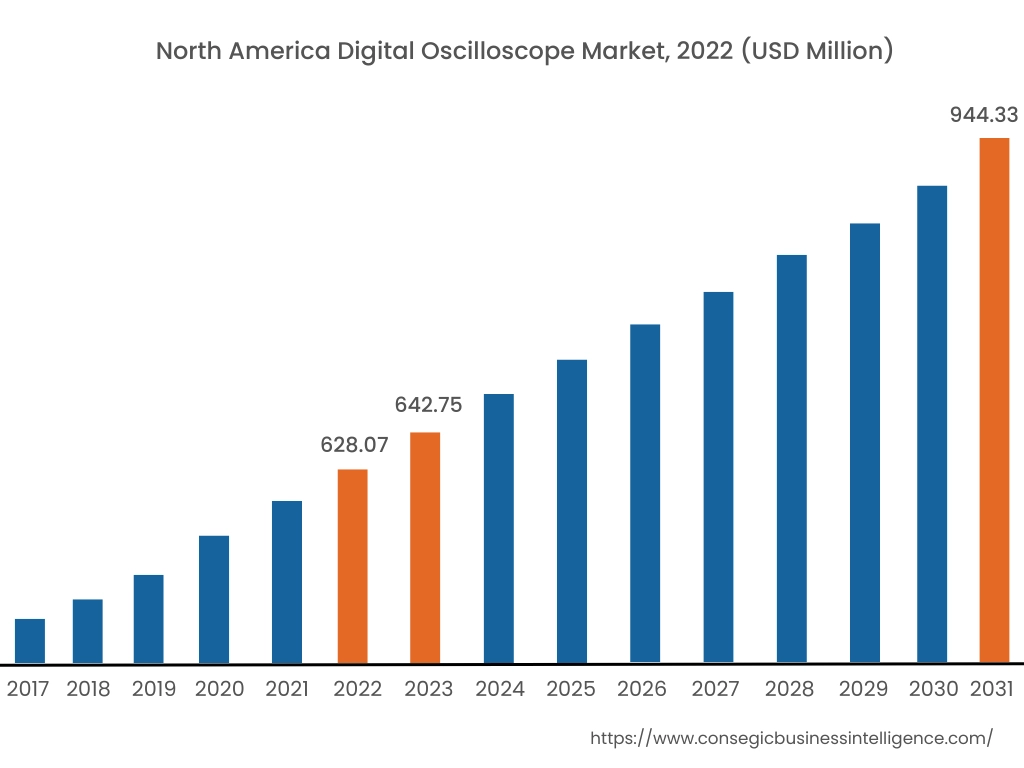
Asia Pacific region was valued at USD 418.01 Million in 2024. Moreover, it is projected to grow by USD 435.57 Million in 2025 and reach over USD 680.50 Million by 2032. Out of this, China accounted for the maximum revenue share of 32.50%. The digital oscilloscope market analysis depicts that the market growth in the region is driven due to rapid industrialization, increasing demand for advanced electronics, and the expansion of 5G and IoT technologies. Key trends include rising adoption in emerging economies, increased demand for portable and user-friendly devices, and technological advancements in digital signal processing.
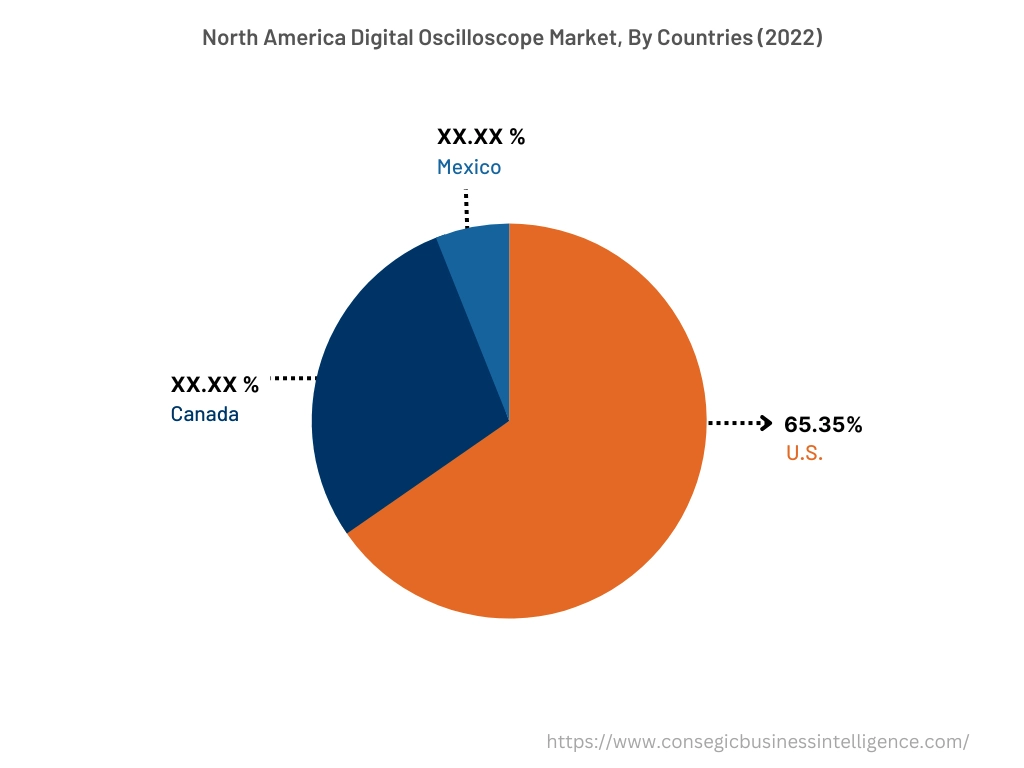
North America is estimated to reach over USD 866.10 Million by 2032 from a value of USD 571.84 Million in 2024 and is projected to grow by USD 592.18 Million in 2025. The market is primarily driven by factors including the increasing adoption of wireless communication systems, advancements in automotive technology, and the presence of key players in the region.
In Europe, the market is growing due to technological advancements, increasing demand, and regulatory support, in turn boosting the digital oscilloscope market expansion. The digital oscilloscope market analysis in the Middle East, Africa, and Latin America, market is driven by rising factors including industrial growth, technological advancements, industrial diversification, and the specific needs of various sectors including healthcare, consumer electronics, and others.
Top Key Players & Market Share Insights:
The digital oscilloscope industry is highly competitive with major players providing solutions to the national and international markets. Key players are adopting several strategies in research and development (R&D), product innovation, and end-user launches to hold a strong position in the global digital oscilloscope market. Key players in the digital oscilloscope industry include -
- OWON Technology Inc. (China)
- Good Will Instrument Co., Ltd. (Taiwan)
- Agilent Technologies Inc. (USA)
- Siglent Technologies (China)
- Keysight Technologies (USA)
- Fluke Corporation (USA)
- Tektronix Inc. (USA)
- Teledyne LeCroy (USA)
- Olimex (Bulgaria)
- B&K Precision (USA)
Digital Oscilloscope Market Report Insights :
| Report Attributes | Report Details |
| Study Timeline | 2017-2031 |
| Market Size in 2031 | USD 2,379.39 Million |
| CAGR (2023-2031) | 4.90% |
| By Type | Digital storage oscilloscopes (DSO), Digital phosphor oscilloscopes (DPO), Mixed signal oscilloscopes (MSO), and Digital sampling oscilloscopes |
| By Product Type | Benchtop Digital Oscilloscope and Handheld Digital Oscilloscope |
| By End Use | Automotive, Telecommunication, Consumer Electronics, Aerospace & Defense, Healthcare, and Others |
| By Region | North America, Europe, Asia-Pacific, Latin America, and Middle East & Africa |
| Key Players | OWON Technology Inc., Good Will Instrument Co., Ltd., Fluke Corporation, Siglent Technologies, Keysight Technologies, Rohde & Schwarz GmbH & Co KG, Pico Technologies, Yokogawa Electric Corporation, General Polytronic Systems Ltd., Tektronix Inc., Teledyne LeCroy, Olimex, B&K Precision, Agilent Technologies Inc. |
Key Questions Answered in the Report
How big is the digital oscilloscope market? +
Digital Oscilloscope Market size is estimated to reach over USD 2,379.39 Million by 2032 from a value of USD 1,567.04 Million in 2024 and is projected to grow by USD 1,623.11 Million in 2025, growing at a CAGR of 4.9% from 2025 to 2032.
What are the major segments covered in the digital oscilloscope market report? +
The segments covered in the report are type, product type, end use, and region.
Which region holds the largest revenue share in 2024 in the digital oscilloscope market? +
North America holds the largest revenue share in the digital oscilloscope market in 2024.
Who are the major key players in the digital oscilloscope market? +
The major key players in the market are OWON Technology Inc. (China), Good Will Instrument Co., Ltd. (Taiwan), Fluke Corporation (USA), Tektronix Inc. (USA), Teledyne LeCroy (USA), Olimex (Bulgaria), B&K Precision (USA), Agilent Technologies Inc. (USA), Siglent Technologies (China), and Keysight Technologies (USA).
